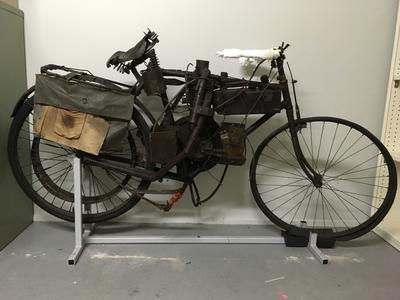Motorcycle [Pearse]
Maker and role
Richard Pearse, Maker
Production date
Circa 1912
See full details
Object detail
Accession number
1964.133
Maker
Production period
Description
Pearse Motorcycle - a pedal cycle converted to power cycle by the addition of a benzene engine. Leather/ plastic handle bars, leather/ plastic feet rests/ pedals. Satchel attached to the back rest above the rear tyre.
Brief History
This bicycle was motorised in 1912 by New Zealand inventor, Richard Pearse, when he was living in Milton, Otago. Pearse attached a spare aero-engine to a pedal powered bike to travel between his farm and the town of Milton. Pearse’s biographer, Gordon Ogilvie, includes memoirs shared by Milton residents of the time describing the sound and sight of the bicycle which was used by Pearse to attend sporting events or collect supplies.
The engine was described by engineer E. Harry as a single cylinder, air-cooled, four stroke petrol engine made from sheet metal, with modifications likely made by Pearse. It was not the first aero-engine Pearse had come across, as records show he had already built at least two of his own aircraft engines while he was experimenting and testing his monoplane – two- and four-cylinder engines described by Pearse in a 1906 patent and the latter by the Temuka Leader in 1909.
It was donated to MOTAT in 1964, as part of the Sir George Bolt collection. In the years after Pearse's death in 1953, Bolt had researched the whereabouts of some of the inventions Pearse had made. This cycle was found on a farm at Tai Tapu in 1959 and reached MOTAT in a relatively intact state.
The engine was described by engineer E. Harry as a single cylinder, air-cooled, four stroke petrol engine made from sheet metal, with modifications likely made by Pearse. It was not the first aero-engine Pearse had come across, as records show he had already built at least two of his own aircraft engines while he was experimenting and testing his monoplane – two- and four-cylinder engines described by Pearse in a 1906 patent and the latter by the Temuka Leader in 1909.
It was donated to MOTAT in 1964, as part of the Sir George Bolt collection. In the years after Pearse's death in 1953, Bolt had researched the whereabouts of some of the inventions Pearse had made. This cycle was found on a farm at Tai Tapu in 1959 and reached MOTAT in a relatively intact state.
Media/Materials
Other name
Power Cycle
Collection
Credit Line
Richard Pearse. Circa 1912. Motorcycle [Pearse], 1964.133. The Museum of Transport and Technology (MOTAT).
Related exhibitions


Public comments
Be the first to comment on this object record.